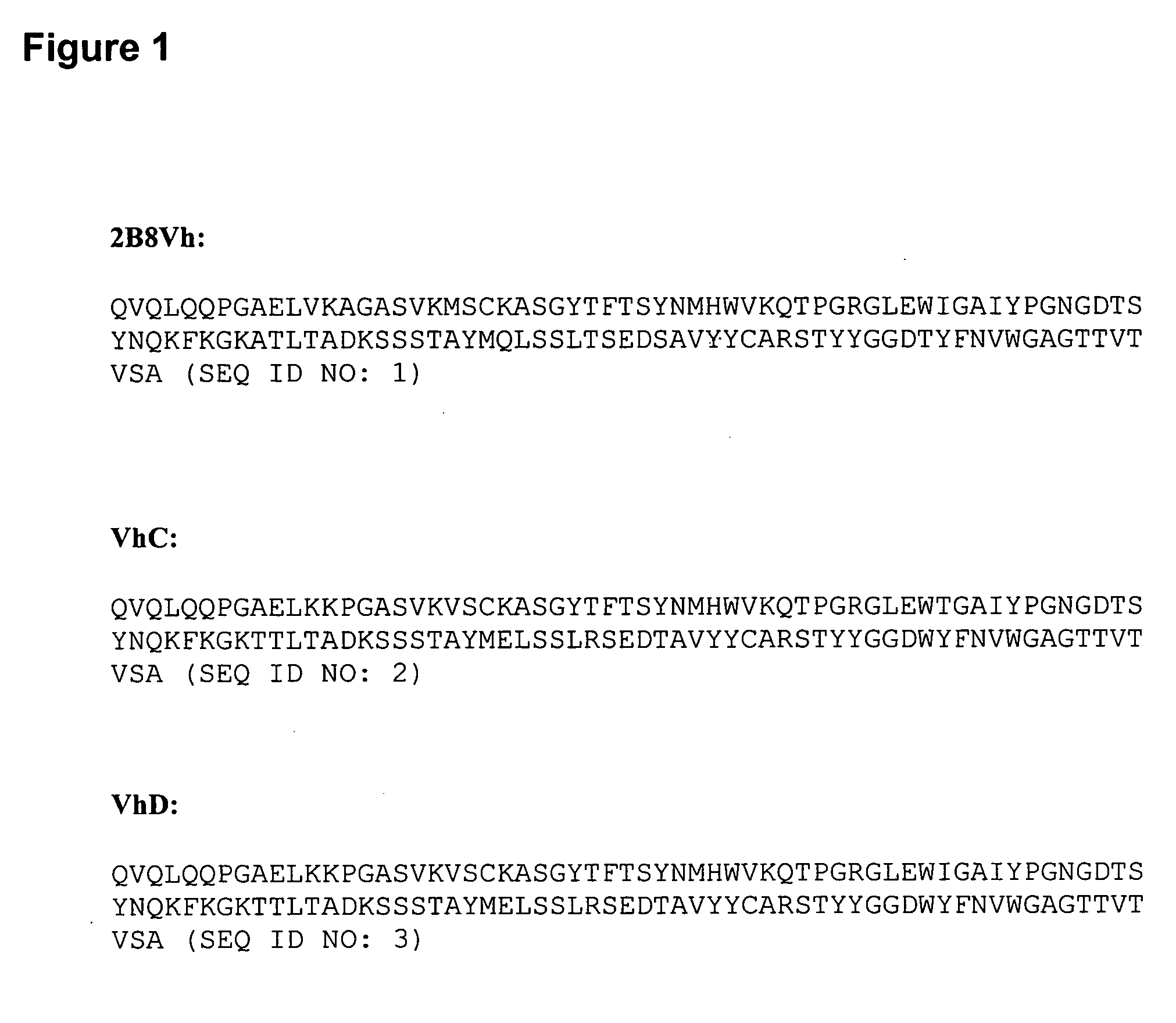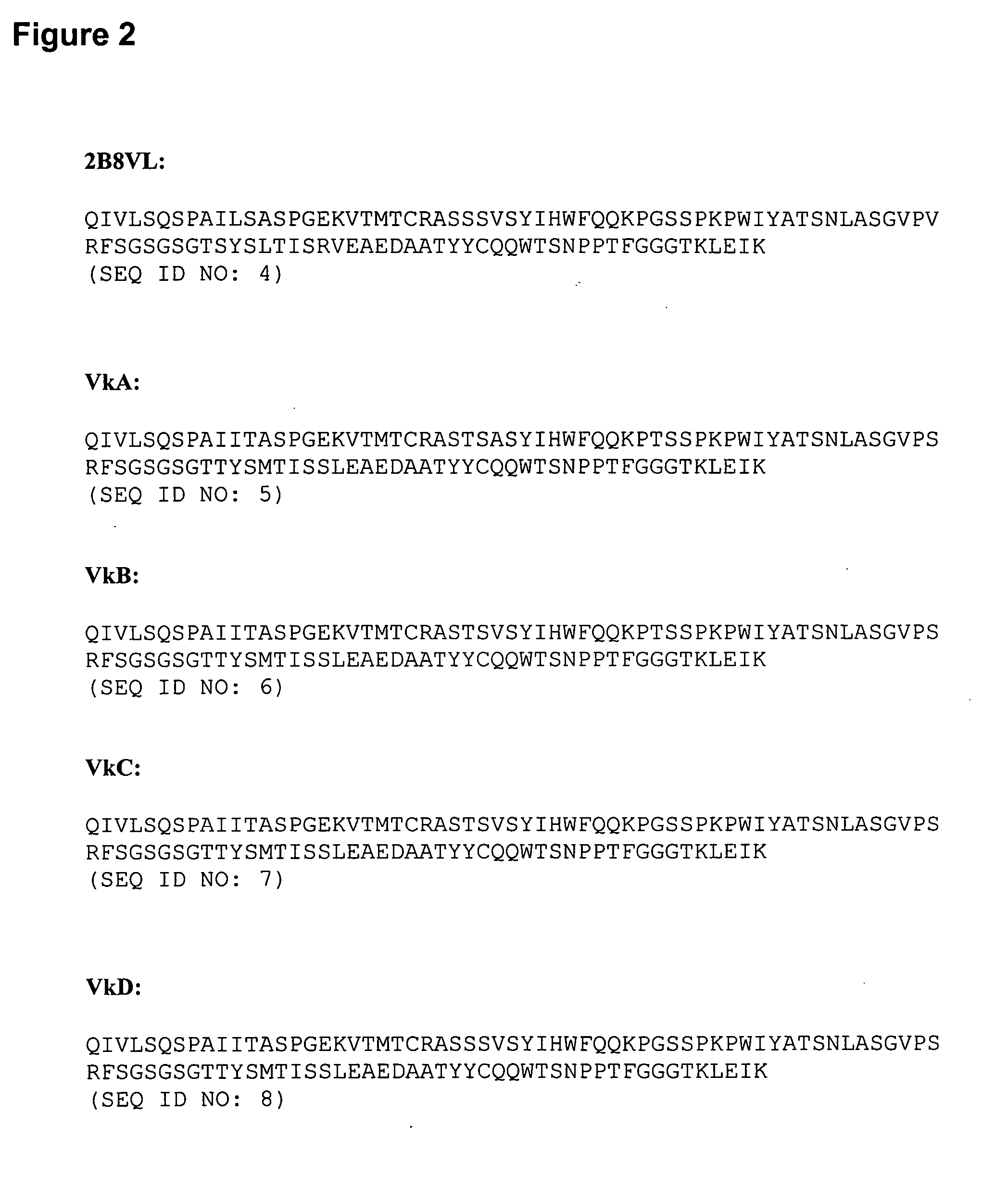CD20-Binding polypeptide compositions and methods
- Summary
- Abstract
- Description
- Claims
- Application Information
AI Technical Summary
Benefits of technology
Problems solved by technology
Method used
Image
Examples
example 1
Methods and Reagents for Expressing CD20-Binding Polypeptide Compositions which are “Deimmunised” or “Epitope-Deleted” Leu16 Antibodies.
[0090] 1A: Cell Culture and Transfection
[0091] In order to obtain stably transfected clones, plasmid DNA was introduced into the mouse myeloma NS / 0 cells by electroporation. About 5×106 cells were washed once and re-suspended with phosphate buffered saline solution (PBS). Ten μg of linearized plasmid DNA was then incubated with the cells in a Gene Pulser cuvette (0.4 cm electrode gap, BioRad) for 10 minutes on ice. Electroporation was performed using a Gene Pulser (BioRad) with settings at 0.25 V and 500 μF. Cells were allowed to recover for 10 minutes on ice, after which they were re-suspended in growth medium and then plated onto 96-well plates. Stably transfected clones were selected by growth in the presence of 100 nM methotrexate (MTX), which was introduced two days post-transfection. The cells were fed every 3 days for 2 or 3 more times and ...
example 2
Determination of the Relative Binding Affinity of the Epitope-Depleted Leu-16 Antibody-IL2 Fusion Protein for Daudi Tumor Cells Presenting the CD20 Antigen.
[0102] The binding of a epitope-depleted Leu16-IL2 fusion protein of the invention, Leu16VhY / VkZ-IL2 (also referred to as “anti-CD20 PC2” and AbVhY / VkZ-IL2), to Daudi lymphoma cells bearing the CD20 antigen, was compared with the binding of other known anti-CD20 antibodies using flow cytometry analysis. Approximately 106 Daudi cells were used with various concentrations of antibody or antibody-IL2 fuision protein in a 100 μl volume, for each sample tested. Anti-CD20 PC2 is a fusion protein of IL2 bound to the C-terminus of the heavy chain of a modified Leu16 chimeric antibody having the VhY and VkZ variable regions and human IgG1-derived and kappa constant regions. As shown in Table 1, anti-CD20 PC2 was able to bind to CD20-expressing cells at least as well as the corresponding chimeric Leu16-IL2 fusion protein chLeu16-IL2, whic...
example 3
Antibody-Dependent, Cell-Mediated Cytotoxicity (ADCC) Driven by Anti-CD20-IL2 Fusion Proteins of the Invention Carrying Mutations that Reduce Immunogenicity.
[0103] NS / 0 cells that express CD20 were exposed to various concentrations of antibody or antibody-IL2 fusion protein and tested for ADCC lysis according to standard procedures. A typical data set is shown in FIG. 5. Proteins tested were as follows: chLeu16, which is a chimeric antibody consisting of the Leu16 mouse V-regions and human IgG1 constant regions; chLeu16-IL2 which is a chimeric antibody consisting of the Leu16 mouse V-regions and human IgG1-derived constant regions, with a human IL-2 moiety fused to the C-terminus of the antibody heavy- chain; anti-CD20 PC2 (also referred to as Ab(VhY / VkZ)-IL2 and Leu16VhY / VkZ-IL2), which is identical to chLeu16-IL2 except that the VhY and VkZ variable domains shown in FIGS. 3 and 4 are present instead of the native murine Leu16 V-regions; C2B8, which is a chimeric antibody consisti...
PUM
| Property | Measurement | Unit |
|---|---|---|
| Composition | aaaaa | aaaaa |
| Light | aaaaa | aaaaa |
Abstract
Description
Claims
Application Information
 Login to View More
Login to View More - R&D
- Intellectual Property
- Life Sciences
- Materials
- Tech Scout
- Unparalleled Data Quality
- Higher Quality Content
- 60% Fewer Hallucinations
Browse by: Latest US Patents, China's latest patents, Technical Efficacy Thesaurus, Application Domain, Technology Topic, Popular Technical Reports.
© 2025 PatSnap. All rights reserved.Legal|Privacy policy|Modern Slavery Act Transparency Statement|Sitemap|About US| Contact US: help@patsnap.com



